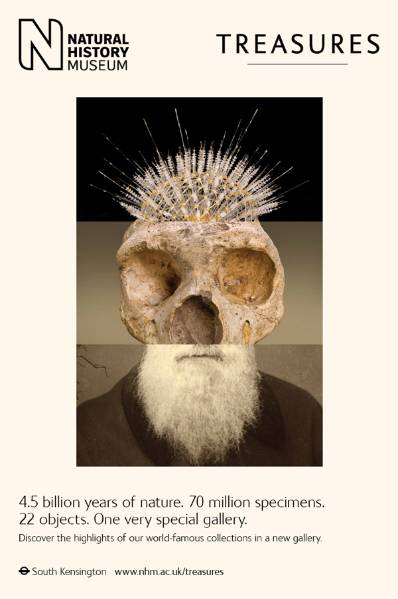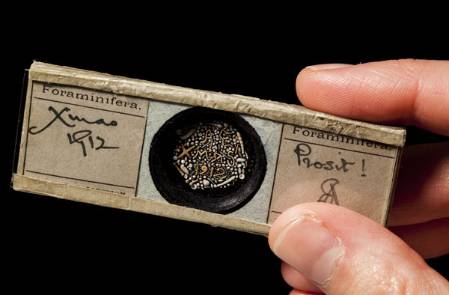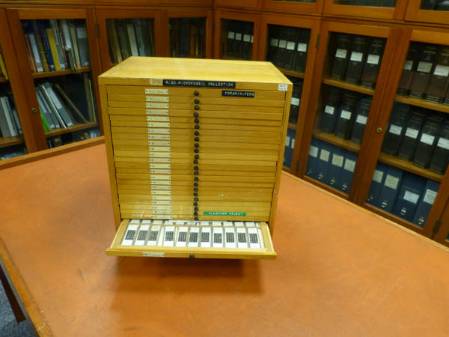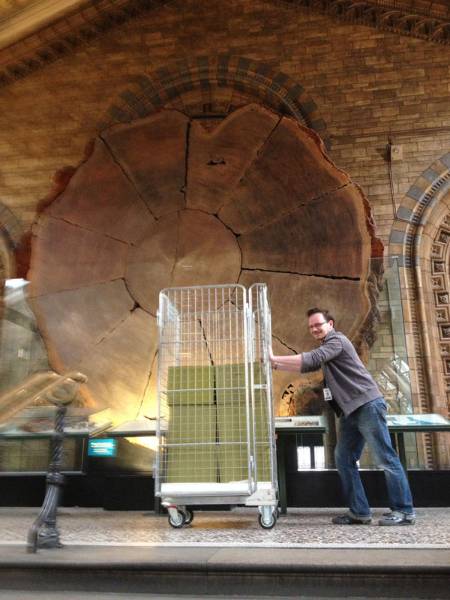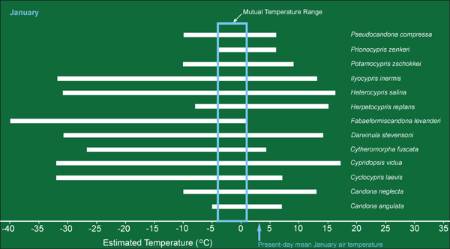The end of March and start of April at the Museum marks the end of our reporting year so I thought I'd report on the news from the micropalaeontology collections over the past year. This includes details of national press coverage, exhibitions, loans, acquisitions, disposals, visitors, university teaching, projects by artists and answers to big questions about past climates.
Our most iconic specimen as advertising for the Treasures Gallery as 'hair to a Neanderthal with Darwin's beard'!
Exhibitions
Microfossils are not the easiest display subjects. However, this year has seen several microfossil themed displays, both in the Museum and galleries elsewhere, that feature or have been inspired by our collections.
The highlight of the year has to be the display of one of our Blaschka glass models of radiolarians in the new Treasures Exhibition in the main hall of the Museum. The radiolarian scale model, multiplied by about 500 times, was a centrepiece of the display and featured heavily in the advertising for the gallery. The gallery has a public voting panel at the end and last time I looked, the Blaschka items were second favourite behind Guy the Gorilla!
The radiolarian model received a large amount of press coverage as part of the advertising of the gallery, including an image in the colour supplement of the Financial Times. I am told that a giant image of the model was projected onto the wall behind the Duchess of Cambridge as she opened the exhibition. A Blaschka video also featured on the Museum's YouTube channel including some additional radiolarian models that are yet to be put on display.
The year started with the the exhibition at the Gasworks Gallery of Irene Kopelman's images inspired by our collection of Antarctic Ocean radiolarians and ended with Gemma Anderson's exhibition of art at the Ebb and Flow Gallery, inspired partly by the loan of some radiolarian specimens from our collections.
Images of coccolithophores from our archives have been on display at the British Museum. Closer to home, Tom, Steve and I used a portable scanning electron microscope to display our microfossil zoo during the Science Uncovered public event in the galleries at the Museum in September.
Microfossil Christmas cards featured in the national media.
Other national press coverage
Our collections of Foraminifera hit the national press at Christmas when the story behind the microfossil Christmas cards was published by the Independent and a gallery of images from the collection were included on the BBC Focus web site.
The cabinet of foraminiferal slides loaned to the University of Birmingham for teaching on the Applied and Petroleum Micropalaeontology course.
Loans to support micropalaeontology teaching
The main loan of the year was to the University of Birmingham who borrowed 730 slides and over 2,500 countable specimens for use in the teaching of the new MSc course in Applied and Petroleum Micropalaeontology. Another loan of 180 slides from the former British Petroleum Collection was sent to support a student project on the same course that will be co-supervised by my colleague Steve Stukins.
Other loans have supported undergraduate projects at the University of Manchester and a PhD student at the University of Edinburgh. A total of 500 images of our specimens or surrogate loans have also been sent out this year.
Tom Hill transporting part of the Modern Pollen and Spores collection past the giant sequoia in the main hall.
Collection enhancements and disposals
In January we transferred over 30,000 slides of modern pollen and spores from the former Botany Department. A good start has been made with rehousing some of the slides that are currently stored in less than adequate conditions. Other major donations have included 5 slide cabinets of Recent Foraminifera donated by Prof Jo Haynes to accompany the former Aberystwyth University Micropalaeontology Collection that arrived in 2000.
Space for these new collections was created by donating a large number of duplicate foraminiferal reprints to the Gryzbowski Library in Poland and a large collection of duplicate ostracod reprints to the University of Brasilia in Brazil.
Some acritarch images taken by Associate Tim Potter that were released on-line database this year.
Details of our collections on-line
About 8,900 microfossil specimen records were added to the museum on-line database this year and completed the transfer of records from our paper fossil foraminiferal registers. Details of about 90,000 microfossil slides are now available on-line covering most of our type and figured collection of fossil foraminifera.
Records from the Richard Dingle Collection of 90,000 ostracods on 2,500 slides were also added to the database this year and a paper detailing the collection published in the Journal of Micropalaeontology. The collection underpins Richard's work on ostracods that has helped illuminate some major questions in evolution, detailed the movements of ancient continents and shown patterns of migration of ostracods across oceans.
1,776 microfossil images from our collection have been posted on-line this year. Images of acritarchs from Tim Potter's collection have been added (see above). Images and videos relating to the Duxbury collection of Cretaceous Dinoflagellates are now available with the specimen details on-line.
A cabinet of former staff member Dr Ray Bate's correspondence relating to the ostracod collection has been transferred to the Museum archive and details of these documents added to the on-line archive search.
Temperature ranges of non marine ostracod species identified by Horton et al. (1992) from a Hoxnian site about 400,000 years old at Woodston, Peterborough. The mutual temperature range for the month of January is calculated and shows slightly lower mean temperatures than the present day (courtesy of Dr David Horne). New records of non-marine ostracod occurrences from our collections have been added to Dr Horne's database this year.
Visitors
We hosted in excess of 200 scientific visitors again this year and welcomed student groups from the University of Birmingham, Imperial College, King's College and the British Science Academy. Academic visitors from universities continue to make up the majority of our visitor numbers with a visit from a post doctoral student from Turkey a highlight. She used the distribution of ostracod species in our collections to add to a database which helps estimate past climatic conditions.
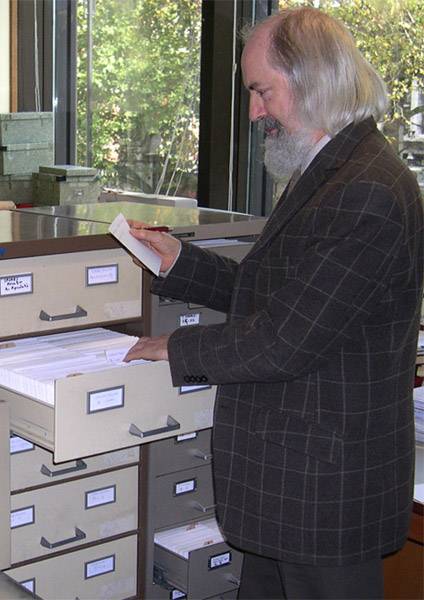 John Williams with part of the Index of Palaeopalynology.
John Williams with part of the Index of Palaeopalynology.
Publications on our collections
This is a harder question to answer as we usually rely heavily on our collection users to provide details of their publications that cite or figure our collections. I know of at least three major mongraphs in preparation/press and this year a book proposal submitted by Micropalaeontology staff and associates on the Museum Iraq Petroleum Microfossil Collection was accepted by Wiley Blackwell.
A short article on the John Williams Index of Palaeopalynology was also published in the journal Palynology and we continue to welcome palynologists to use the index for their research.
Thanks
I hope this does not sound like I am soley responsible for carrying out all of these tasks relating to visits, loans, donations, collections moves and exhibitions. It has very much been a team effort with so many collaborators that is would be impossible to list them all here. I would particularly like to thank Museum Scientists Tom Hill, Steve Stukins and our volunteers Daryl, Johanna, Freya, Heather and Stephanie without whose support this extremely successful year for the collections would not have been possible.
And finally ...
Keep in touch with what we're doing in Micropalaeontology with our @NHM_Micropalaeo Twitter feed that we also launched this year, which is where you'll hear about new positions in the labs and about our recent activities like this podcast from Palaeocast in which I featured.



